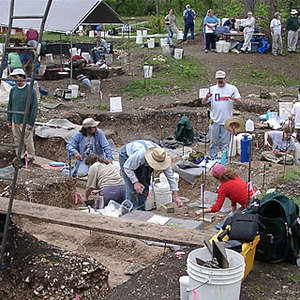
|
| ©The Gault School |
| Excavations at the Gault site in central Texas |
Florence, Tex. - "Look at that - isn't it gorgeous?" Sandy Peck asks as she rinses dirt from a flaked stone about the length and width of a pinky finger. Peck runs a hose over soil on a fine-mesh screen, prodding at stubborn clods of clay with a muddy glove. "Look, there's another one."
View Slide Show of the Dig
Peck, sorting soil that had been disturbed by a recent thunderstorm, is a volunteer looking for artifacts in the Gault Valley in central Texas, some 40 miles (65 kilometers) north of Austin. The valley hasn't changed much over the last several thousand years: A spring-fed creek still runs among live oaks and pecan trees, jackrabbits and deer still live on the nearby uplands, and cobbles of chert, ideal for making stone tools, still bulge from the valley's limestone walls. Today, however, instead of working hides and shaping stones as they did 13,000 years ago, humans painstakingly sift the soil in search of ancient artifacts that will overturn long-held assumptions about the earliest Americans.
Since the 1930s textbooks have taught that the New World's first inhabitants, known for the town in New Mexico where their spear points were discovered, walked from Siberia to Alaska about 13,300 years ago. The Clovis people were believed to be highly mobile nomadic hunters, never settling in one place, instead surviving on massive mammoths, mastodons and ancient bison.
But in excavations starting in 1998 Gault has revealed that Clovis people lived at the site for extended periods over a span of 300 years, says Michael Collins, a research associate with the Texas Archeological Research Laboratory. The evidence? Scientists have found numerous tools manufactured from local stone, used until they were worn, then repaired repeatedly until they finally were discarded. In other words, Paleo-Indians were members of a settled community. "We're redefining Clovis," Collins says.
It's unusual to find a site that has both materials for stone tools and "enough resources that people could camp and live right there," says Dennis Stanford, head of the Smithsonian National Museum of Natural History anthropology department who has visited the Gault site several times. "Usually you don't get both, but at Gault you get the whole show. So it looks like people were living there for extended periods of time."
Gault also suggests previous assumptions about Clovis's diet were wrong. Sure, they ate mammoth and bison, but archaeologists are also finding bones from frogs, turtles, snakes and rabbits. "Coming home with three rabbits isn't as dramatic as the museum mural image of Clovis people sneaking up on a mammoth," says Collins's colleague, Andy Hemmings, but probably better reflects day-to-day life.
Not everyone is convinced that Clovis was such a homebody. "Gault is not completely rewriting what we know about Clovis," says Robert L. Kelly, head of the department of anthropology at the University of Wyoming. "[Collins] could be right that this particular population of Clovis was more settled than other peoples. But is Gault the pattern or is Gault an aberration? We don't know."
The Clovis finds would be dramatic enough, but Collins also claims to have found evidence of an earlier culture at Gault. In 2002 the team dug below Clovis layers and promptly found hundreds of stone flakes. The surrounding soil was dated to 350 years before Clovis. When they kept digging, the team dated other materials to even further back, although Collins used a technique that others have questioned, and that even he acknowledges is imprecise.



Reader Comments
to our Newsletter